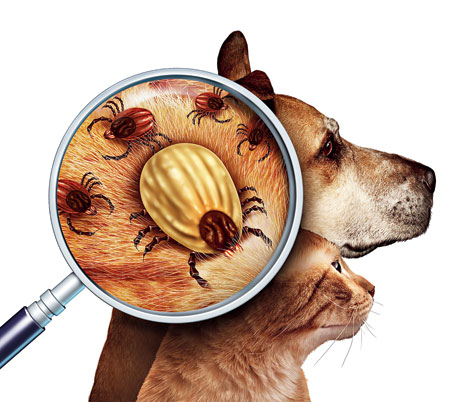
Every third adult dog coming to my chamber is down with tick fever these days,” says vet Krishanu Ghosh, who sits at Animel Planet’s Salt Lake and New Town centres. “If diagnosed early, medicines can cure the dogs but in some cases it’s too late.”
Protip Chakraborty, a partner at Baguiati’s Animal Health Pathology Lab & Diagnostic Centre, says they are falling over backwards with tick fever tests. “Till January we were doing three or four such tests a day. Now we are 12 to 16! Tick fever tends to worsen in the monsoon so we have asked our parasitologist to give us extra hours in the coming weeks.”
It’s pet parents who are fretting the most. “We lost our Labrador Snowy to tick fever last year and this time our other Lab Buddy has got it,” said Ananya Mitra of Uniworld City, who had rushed Buddy to Animel Planet for a tick bath and doctor’s consultation.
The Telegraph Salt Lake speaks to vets to understand why ticks are so dangerous and how to keep our dogs safe from them.
What are ticks?
These are the tiny eight-legged parasites that stick to your dog’s body. “They feed on mammals, birds and reptile’s blood,” says Soumitra Pandit, veterinary parasitologist and assistant professor at the West Bengal University of Animal and Fishery Sciences in Belgachhia. “The problem at hand is the Brown Dog Tick, that prefers dog’s blood and that is spreading rapidly at present.”
I’ve seen some red ticks and some swollen grey ticks on my dog. Are they the same?
Ticks are the ultimate survivors. For starters, they lay nearly four thousand eggs at a time. The eggs are laid — not on the dog’s body but — in cracks and crevices around the house.
The eggs hatch and the new-born six-legged larvae wait to latch on a host (dog, cat etc) and feed. These are the red ticks you see and they can stay hungry for up to nine months before climbing on to a dog.
Once latched to the dog, the tick feeds for six days. It will then drop off to molt into a nymph. It can hide on a sofa, your clothes or walls. Once again it will wait to latch on to a dog, feed and drop off. This time it will molt to become an eight-legged grey coloured adult. It latches on to the dog, feeds till it swells, mates and drops off to lay eggs.
If I see a tick on my dog can I yank it out?
Yes, but it’s not that simple. When ticks latch on a dog, they cut the skin and force in what would appear like a pair of inverted teeth. If you force it out, the locked teeth will tear the skin further, leaving it susceptible to infection.
To pull out a tick, do not use your hands. Use forceps and gently pull up the tick’s behind. It will eventually release the grip from its mouth.
Do not squish the tick and toss it in the bin. Do not flush it down the sink or toilet. Ticks are known to crawl back out and head to your dog again. Either burn it or toss it in kerosene.
If a tick bites my dog, will he get tick fever?
Not necessarily. “Ticks are vectors for diseases like babesia and ehrlichia caniese. This means that if a tick bites an animal that has these diseases, it becomes a carrier. The disease will not harm the tick but will spread to the next animal it bites. The disease will then attack the dog’s organs and blood cells,” says Pandit.
Puppies and aged dogs are most susceptible to tick-borne diseases as their immunity is low. Even if a tick is not carrying a disease, it is harmful to your dog as it can cause anaemia and suck their nutrition.
Ticks can bite people too but humans aren’t their favourite meal.
What are the symptoms of tick fever?
While a dog’s normal body temperature is 101°F, an infected dog would have 103° to 106°F fever for three to four days. Warning signs are a dry nose and muzzle, excessive panting, lethargy, weakness and loss of appetite.
If your dog shows symptoms, consult a vet and arrange for blood tests. It is best to have the dog’s blood collected when he is running temperature.
How can I stop ticks from getting on my dog?
“Many people feel that ticks are unavoidable on dogs and that’s a dangerous thought. A single infected tick can kill a dog and so the existing ones must be eliminated and new ticks must be stopped from latching on,” says Ghosh, adding that there is no vaccine against these diseases.
Here are a few items to protect your dog from ticks-

• Bugz Free cotton T-shirt
Deko, the Pug from New Town, is wearing a treated T-shirt that repels ticks, fleas, mosquitoes etc. “Make your dog wear this when going for a walk,” says Tapan Gupta of Animel Planet. The Pug-sized T-shirt costs Rs 999.

• Kiltix collar
“This collar keeps ticks away and we are recommending dog-owners to keep them on puppies right from the start,” says Gupta. The collar costs Rs 650 and lasts seven months. It has to be kept away from water.

• Ridd, Butox tick baths
“These medicines are very strong and are only to be used in extreme cases. We put a muzzle on the dogs during the bath so they don’t lick it off accidentally,” says Rana Karmakar of IA Block’s Pet Mansion. He has given five dogs tick baths last week. “This when there were hardly any such cases six months ago.” A tick bath costs about Rs 300 here.

• Vivaldis Vi-Fi Forte
These are single-dose tubes that are to be applied along the dog’s spine, from head till the tail bone. “Part the hair and apply it on the skin. The medicine will gradually spread over his body and keep ticks away,” says Karmakar. “We have almost run out of tick powder too. Such is the rush that even the distributor says he’s almost out of stock.”
Pictures by Shubham Paul










